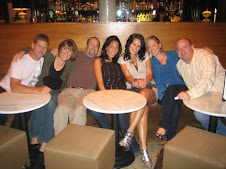We have a customer who came to us with an exterior paint problem. She had her house painted last year, and earlier this spring (right after the first great weather of the year) she noticed the emergence of good-sized bubbles on the side of her house.
Naturally, it looked to her that the paint had failed. And not only that, but in less than 6 months from it's application. Imagine how frustrating that must be.
Bill, one of our senior staff paint experts went out to the jobsite with our Pratt & Lambert rep. to assess the situation. When they examined the underside of the bubble, they saw that they weren't only looking at paint, they were also looking at the PRIMER. In other words, the paint was doing its job very well and sticking like crazy, it was the primer that had released from the siding, not the paint.
This was a primer failure. To complicate matters further, the primer was a Sherwin Williams product, it did not come from our store. And worst of all - our records show that the painter purchased the paint at the end of October of last year. Meaning the paint wasn't applied until about the first week of November.
We are guessing that the primer was applied earlier in the season, absorbed some moisture before the paint film was applied - then on the first hot day of the year, the moisture steamed up and caused the bubbling to occur. Paint school 101: Water always will find it's way out.
So... is this an applicator failure or a product failure?
Wednesday, June 27, 2007
Thursday, June 21, 2007
Tuesday, June 12, 2007

This is a shot of my friend Ron's store, Oswego Paint & Home Fashion, in Oswego, IL.
They are remodeling their shop, and as part of the redo they are using lots great colors.
I wanted to share this shot with you because it perfectly illustrates the whole concept of tinted primers.
In today's design market, deep-toned colors are in high demand. We are seeing a lot of clear Reds being specified, for example.
The red pigment is very transparent, and that usually translates to multiple coats (read:5 or more) on the wall to get full coverage. In this image, you can see the painter is actually painting "Mojo" (the clear red) over what looks like a maroon wall. It might seem a bit counter intuitive, but the maroon is actually specifically formulated for "Mojo".
Our Lead-Geeks (whom I love and are a father/son duo named Bob and Rob. Really!) analyze how light waves travel through the topcoat color, hit the primer color and bounce back up. They mathematically calculate the ideal primer color for each topcoat by looking at the light waves. There is a bright yellow in the C2 palette that had an army green primer - who knew? Yet these specially formulated primers allow the painter to almost always be able to count on only using 2 top coats - even for super clear colors like the "Mojo" pictured here.
Labels:
C2 Paint,
color Mojo,
paint coverage,
tinted primers
Monday, June 04, 2007
My New Favorite Color
When I repainted my house (I finally ended up using C2's Sea Salt) - I decided to try a color for the front door that wasn't black or deep burgundy... I love the sophistication of black doors, but this house is more "cottage" than "manor" and the black would look a bit too tres elegant.
Burgundy has just been so done. Over and over. I love it, it's attractive, but I was looking for something a little different.
Ah ha. C2's Space.
In some lights it's almost a black, other lights it's deeeeeeep turquoise. You look at it and think, "Is it green, is it blue, or is it black?" Perfect! Painted it in high gloss for that yummy finish that looks like it came from an old door off a 400-yr old house in Europe.
Speaking of gloss finishes... When you are choosing a paint color, you need to factor in the sheen and the way it will reflect the light. The Space color I chose is a perfect example of how sheen can take a color that looked somewhat dull on the chip - but once mixed in a high gloss it came alive. The light reflection created a depth for the dark color. The more matte the finish, the flatter this color would appear. And while this would be great for a media room, for example, in the more matte finish - for the front door it would have looked dead.
My trick for simulating the gloss on my paint chip: I painted a small corner of the chip with clear nail polish. What a difference. So there is your helpful hint of the day, my friends. If you don't have polish handy, you can also try shiny cellophane tape to replicate the sheen (even spit works - in a pinch! But only amongst your friends, please!)
Burgundy has just been so done. Over and over. I love it, it's attractive, but I was looking for something a little different.
Ah ha. C2's Space.
In some lights it's almost a black, other lights it's deeeeeeep turquoise. You look at it and think, "Is it green, is it blue, or is it black?" Perfect! Painted it in high gloss for that yummy finish that looks like it came from an old door off a 400-yr old house in Europe.
Speaking of gloss finishes... When you are choosing a paint color, you need to factor in the sheen and the way it will reflect the light. The Space color I chose is a perfect example of how sheen can take a color that looked somewhat dull on the chip - but once mixed in a high gloss it came alive. The light reflection created a depth for the dark color. The more matte the finish, the flatter this color would appear. And while this would be great for a media room, for example, in the more matte finish - for the front door it would have looked dead.
My trick for simulating the gloss on my paint chip: I painted a small corner of the chip with clear nail polish. What a difference. So there is your helpful hint of the day, my friends. If you don't have polish handy, you can also try shiny cellophane tape to replicate the sheen (even spit works - in a pinch! But only amongst your friends, please!)
Subscribe to:
Posts (Atom)







